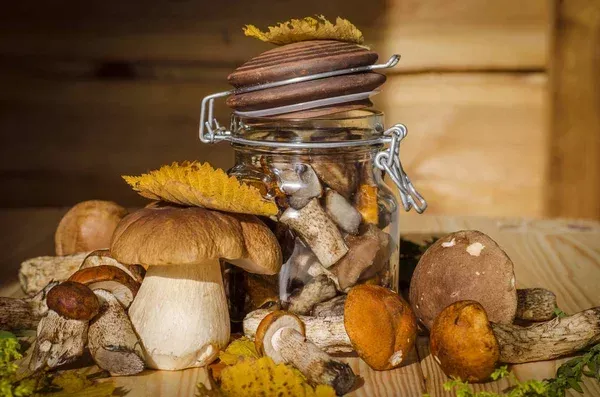Grain Jars Last Surprisingly Long (If Stored Right)
Grain jars are an excellent way to store grains for long-term storage. Not only do they keep your grains safe from pests, but they also help you save money by allowing you to buy in bulk and store large amounts of grains for a longer time. With the right storage techniques, grain jars can last surprisingly long.
With proper storage and care, grain jars can last for several months to even a few years, depending on the type of grain and storage conditions. When grains are stored in an airtight container, away from heat and moisture, they can maintain their quality and freshness for an extended period.
Know about how long grain jars last as well as how long you can store grain spawn. We’ll provide cost-effective ways to ensure that you have a supply of grains on hand at all times.
Summary
- The key to storing grain jars properly is to keep them in a cool, dry, and dark place.
- It's also important to ensure that the jars are airtight, as exposure to air can cause grains to oxidize and go rancid over time.
- Different types of grains have different storage requirements, so it's important to follow specific instructions for each type of grain.

On this page:
Grain Jars Last for Months to Years
The lifespan of grain jars can vary depending on various factors, such as the type of grain, storage conditions, and how well the jars are sealed. Generally, properly stored grain jars can last for several months up to a few years.
Some grains, such as whole wheat flour or cornmeal, have a shorter shelf life and can start to go rancid within a few months if not stored properly. Other grains, such as white rice or quinoa, can last for up to a year or more if stored in a cool, dry place in an airtight container.
Grains that have been processed or refined, such as white flour or white rice, have a longer shelf life compared to their whole-grain counterparts. This is because the refining process removes the outer layer of the grain, which contains oils that can turn rancid over time.

You Can Store Grain Spawn for Months to A Year
The storage lifespan of grain spawn can vary depending on the storage conditions and the type of grain used. Generally, properly stored grain spawn can last for several months, up to a year.
When stored properly, grain spawn made with rye or wheat can last for several months, up to around 6–8 months. However, it's worth noting that the storage lifespan can be reduced if the grain spawn is exposed to moisture or high temperatures, which can cause the mycelium to grow poorly or become contaminated with unwanted microorganisms.
Here's How to Properly Store Grain Jars
Proper storage of grain jars is crucial to ensuring that they remain fresh and free from spoilage. Below are some tips on how to store grain jars. By following these tips, you can extend the lifespan of your grain jars and ensure that they remain fresh and free from spoilage.
1. Choose the right container to store grain jars
When choosing a container to store grain jars, it's important to consider factors such as airtightness, material, and size. Here are some tips on how to choose the right container to store grain jars:
-
Choose a container that is airtight to prevent exposure to air and moisture. Glass jars with tight-fitting lids or vacuum-sealed bags are good options. Avoid containers that are not airtight, such as plastic bags or containers with loose-fitting lids.
-
Choose a container made from a non-reactive material that won't leach chemicals or odors into the grains. Glass, stainless steel, and food-grade plastic are good options.
-
Choose a container that is the right size for the amount of grain you need to store. A container that is too large can expose the grains to excess air, while a container that is too small can make it difficult to measure out the grains.
-
Choose a container that allows you to see the contents inside. This makes it easier to keep track of the quantity and quality of the grains and helps prevent you from accidentally using old or spoiled grains.
-
Choose a container that is reusable and easy to clean. This will save you money in the long run and help reduce waste.

2. Store the grain jars in a cool, dry place
Storing grain jars in a cool, dry place is important to ensure their freshness and prevent spoilage. Here are some tips on how to store grain jars in a cool, dry place:
-
Choose a location that is cool, dry, and away from sources of heat and moisture, such as a pantry or cupboard.
-
Exposure to sunlight can cause the temperature to rise and create condensation, which can lead to moisture buildup in the jars. Store the jars in a dark location, such as a cabinet or closet, to avoid exposure to sunlight.
-
If you live in a humid climate, consider using a dehumidifier to reduce moisture in the air. This can help prevent moisture buildup in the jars and extend their shelf life.
-
Avoid storing the jars near appliances that generate heat, such as ovens or refrigerators, as this can cause the temperature to rise and create moisture buildup.
-
Store the jars off the ground to prevent exposure to moisture and pests. Use shelves or storage racks to keep the jars elevated.
3. Label and date the jars for storage
Labeling and dating your grain jars is an important step to keep track of their storage lifespan and ensure that you use them before they expire. Here are some tips on how to label and date grain jars for storage:
-
Use a permanent marker to label the jar with the type of grain, the date of storage, and any other relevant information, such as the source of the grain or the date of inoculation.
-
Make sure the label is clear and easy to read, so you can easily identify the contents of the jar.
-
Place the label in a visible location on the jar, such as on the lid or the side of the jar.
-
Include the date of storage on the label so you know when the grain was stored. This will help you to determine when the grain should be used and to avoid using old or spoiled grains.
-
Use consistent labeling for all of your grain jars, so you can easily identify them and keep track of their storage lifespan.
By labeling and dating your grain jars, you can keep track of their storage lifespan and ensure that you use them before they expire. This will help you avoid using old or spoiled grains and ensure the best results in your mycological experiments or projects.
4. Store different types of grains separately
Different types of grains have different storage requirements, so it's important to follow specific instructions for each type of grain. Store different types of grains separately to prevent cross-contamination and ensure that each grain stays fresh. Use separate tools, such as scoops or measuring cups, for each type of grain to prevent cross-contamination.

5. Use desiccants to store grain jars
Desiccants are substances that absorb moisture from the surrounding environment and can be used to help keep grain jars dry during storage. Here are some tips on how to use desiccants to store grain jars:
-
There are several types of desiccants available, including silica gel, activated alumina, and molecular sieves. Choose a desiccant that is suitable for your needs and budget.
-
Use only a small amount of desiccant in each grain jar, as using too much can lead to overdrying and damage to the grains.
-
Place the desiccant in a separate container, such as a small pouch or sachet, to prevent direct contact with the grains.
-
Seal the container tightly to prevent moisture from entering and interfering with the desiccant's ability to absorb moisture.
-
Check the moisture level of the desiccant regularly to ensure that it is still effective. If it becomes saturated with moisture, replace it with a new desiccant.
By using desiccants to store grain jars, you can help prevent moisture buildup and extend their shelf life. However, it's important to use desiccants correctly and monitor their effectiveness to avoid overdrying or underdrying the grains.


